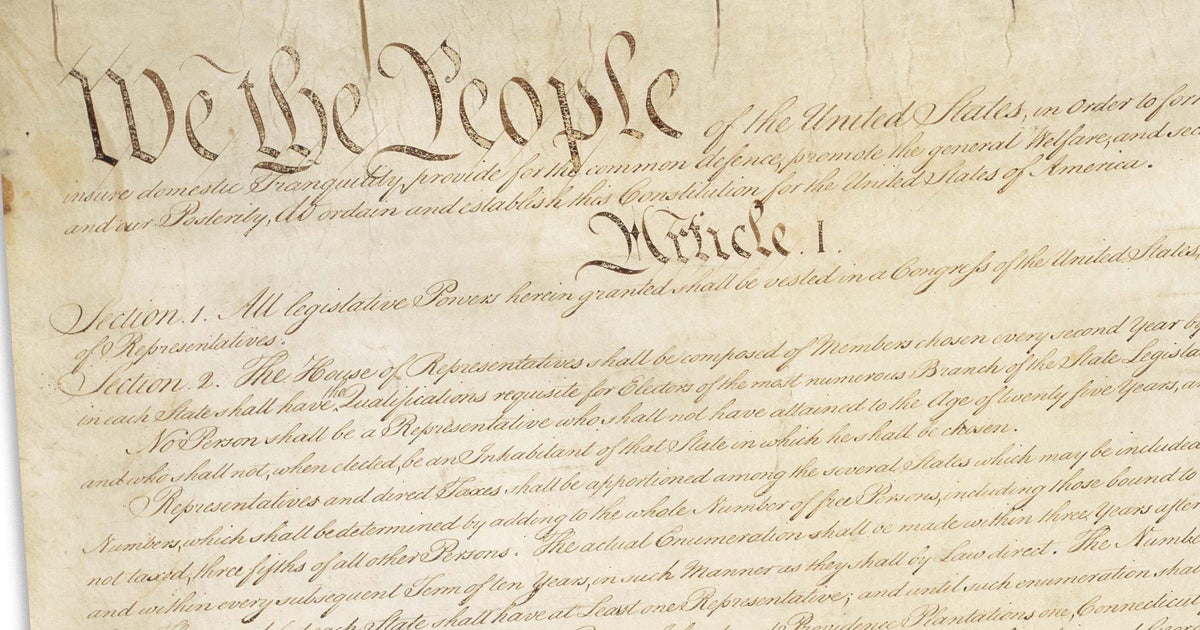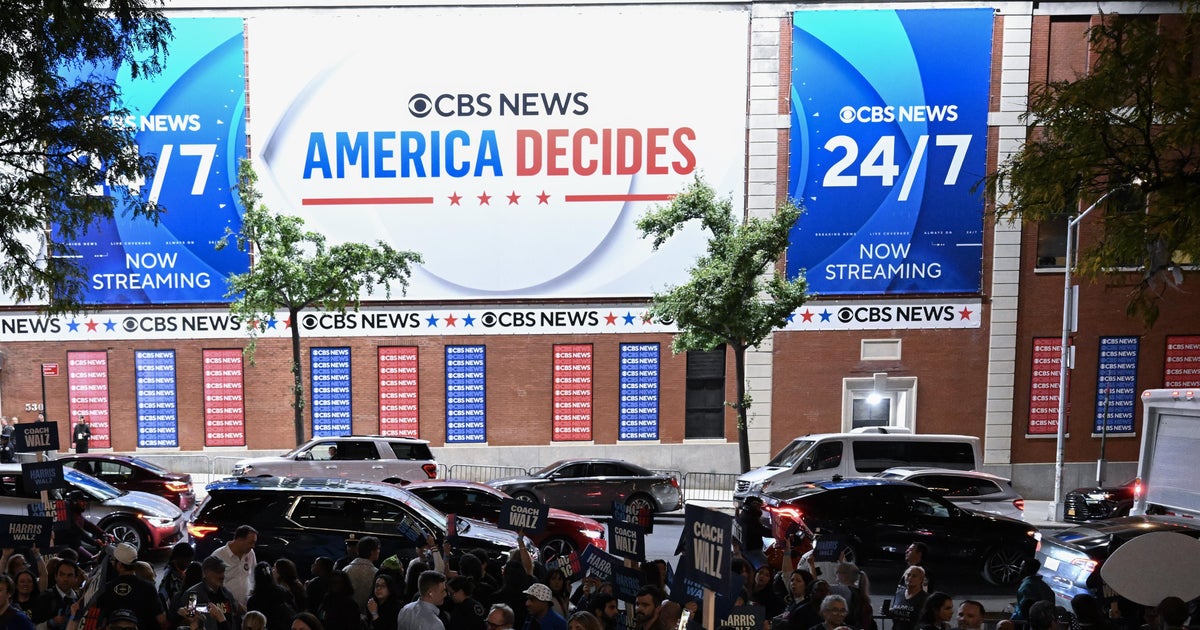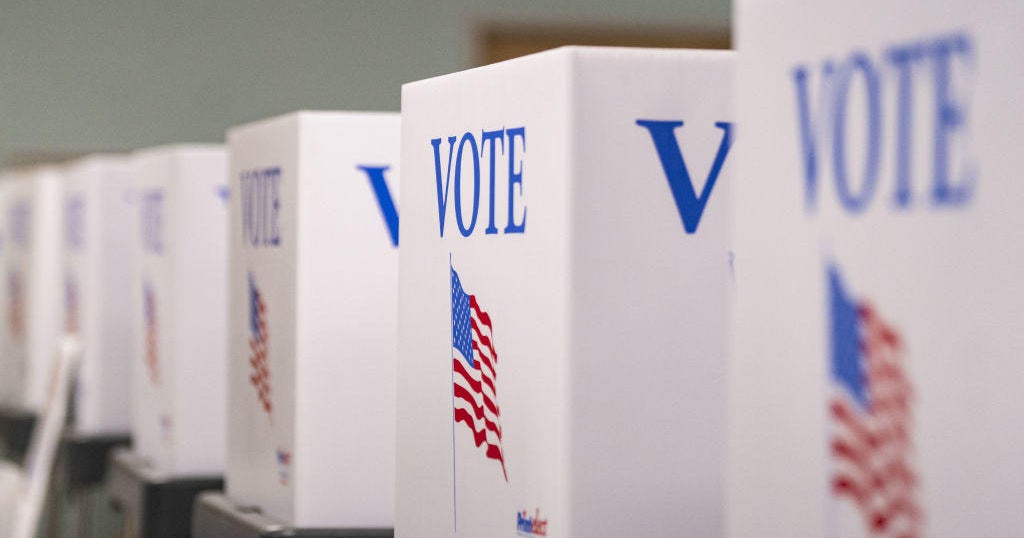CBS News
Zelenskyy pleads for more aid as war with Russia enters third year

Watch CBS News
Be the first to know
Get browser notifications for breaking news, live events, and exclusive reporting.
CBS News
Why do we have the Electoral College? The history of and arguments against the institution

Until polls close on Election Day, millions of people across the United States are casting ballots for their preferred candidates to succeed President Biden in the White House. But determining the winner is not as simple as totaling up how many people voted for Vice President Kamala Harris or former President Donald Trump, because of the Electoral College.
The Electoral College is a controversial step in the U.S. election process that dates back to the 18th century. While there’s a growing movement to try to get rid of it, others defend the system that gives some states more weight in presidential elections.
Why was the Electoral College created in the first place?
Whether the Electoral College is fair or necessary is subject to fierce debate that in some ways dates back to its founding.
The concept emerged during the Constitutional Convention, which took place over a four-month period in 1787 to address issues with the early system of government in the United States. State delegates who attended the convention were divided in their views on how the country should elect its president, with some suggesting Congress should choose the executive and others advocating for direct democracy, where citizens would vote to elect their leader. At the time, the right to vote was almost entirely restricted to White men who owned property.
What to do about the method for selecting a president became a lingering debate at the convention, said Michael Thorning, director of the Bipartisan Policy Center’s democracy project, who told CBS News the issue was finally passed off to a group tasked with resolving prior disagreements over certain areas of the Constitution. It was called the Committee on Unfinished Parts.
Committee members settled on the Electoral College as a compromise.
“There were some attendees of the Constitutional Convention who did not trust the popular will as much,” said Thorning. “They were concerned that you would be asking people with very little political experience, knowledge of the candidates, understanding of their platforms, to select someone that they may not know. And so they may just vote only for the person whose name they recognize, versus the most competent candidate. So, this was a bargain.”
Population size was a major point of contention. Delegates who attended the convention came from large states, like New York and Pennsylvania, and small states, like New Jersey and New Hampshire. While some of the larger states would have favored an election system driven by the popular vote, which would give them a greater say in the election than a state with fewer voters, Thorning said delegates from some smaller states had concerns about being “overrun” by more populous neighbors.
Other large states that sent delegates to the Constitutional Convention had institutionalized slavery. At the time, hundreds of thousands of people were enslaved across the South, amounting to about 40% of the Southern population. Under the notorious “three-fifths compromise” decided during the same convention — which allowed Southern states to count three-fifths of their enslaved populations in their total census — slave-holding states could have considerable power in the House of Representatives and the Electoral College, even though only a fraction of their residents were allowed to vote.
Why do electoral votes matter for presidential elections?
Elements of the Electoral College have changed since the Constitution was drafted, since voting rights expanded and citizens choose their state’s electors. But its fundamental role in picking the president has remained.
“We have 50 state elections all individually happening,” said Thorning. “What’s important is who wins each of the 50 state elections.”
Electors are allocated to each state roughly based on its population, with the number of electors equal to the state’s total number of U.S. senators and House members in Congress. That means even the least-populated states get three, while many states have a dozen or more; the state with the largest population, California, currently has 54.
In most states, it’s a winner-take-all system where all of the electoral votes go to whichever candidate won a majority of the popular vote in the sate. Only Maine and Nebraska have slightly different systems for dividing up their electors based on who won at the congressional district level.
There are 538 electors who will case votes in the Electoral College, and a presidential candidate needs to secure at least 270 of those votes in order to win.
It’s possible to win the popular vote nationwide but still lose the election, if states with enough electoral votes go the other way.
This system also means candidates end up focusing a disproportionate amount of their time and funds on campaigning in a small number of battleground states that could tip the balance in their favor.
Why do we vote if there is an Electoral College?
When voters cast their presidential ballot, they’re actually choosing the group of electors who on good faith will represent the political party is affiliated with their preferred candidate. The people who fill these roles are selected by their party and are typically local officials or committed political supporters.
Thorning called the popular vote for president “a really unofficial gauge of the election.”
“While voters go to the polls and see a presidential candidate on the ballot, they are actually voting for electors who represent those people,” he said. “Whoever the prevailing electors are in those elections, they are the people who ultimately cast the Electoral College votes. So, the post-election period, really, is a process of translating these many popular vote elections into the Electoral College.”
After the November election, the electors gather in each state in December to formally cast their votes for their state’s winner.
Why do some critics want to get rid of the Electoral College?
Critics of the Electoral College primarily take issue with the fact it leaves open the possibility that the outcome may not reflect the results of the popular vote. This happened most recently in 2016, when Trump won the presidency with a majority of Electoral College votes despite Hillary Clinton, the Democratic nominee, winning the nationwide popular vote by almost 3 million.
Similar conundrums played out in a handful of presidential elections before, including in 2000, when George W. Bush won the Electoral College despite losing the popular vote to then-Vice President Al Gore. In that race, the popular vote split between Bush and Gore by a very small margin — much narrower than in 2016.
“Over time, the world has evolved, even while the Electoral College has not evolved so much,” said Thorning. “I think by some standards, the idea that it is not a direct popular vote for president in modern times does strike some people as not being democratic.”
Under one proposed alternative, called the National Popular Vote Compact, states would agree to give their electoral votes to whichever candidate wins the national popular vote — even if it doesn’t match the outcome in their state.
Minnesota Gov. Tim Walz, Harris’ vice presidential running mate, recently spoke out against the Electoral College, saying “we need a popular vote” during a campaign event in California.
“I think all of us know the Electoral College needs to go,” Walz said. “But that’s not the world we live in. So we need to win Beaver County, Pennsylvania. We need to be able to go into York, Pennsylvania, and win. We need to be in western Wisconsin and win. We need to be in Reno, Nevada, and win.”
The Harris-Walz campaign followed up with a statement saying his comments did not reflect their official position on the issue.
Thorning pointed out that while the Electoral College system is partly enshrined in the Constitution, it can be amended.
“I think we should continue to debate aspects of our democracy and what’s in our Constitution,” Thorning said. “But at the end of the day, this is the system so far that we’ve agreed to, and so we have to conduct our politics through the system that we have, and conduct change to that system through the system that we have. There is a way to make that change, if there is support for it.”
CBS News
Where to watch live election results and coverage of the 2024 vote

As former President Donald Trump and Vice President Kamala Harris face off in the 2024 election, and control of Congress is on the line in House and Senate races around the country, millions of Americans will be looking for live coverage of results when the polls close on Tuesday.
CBS News will have extensive coverage of the 2024 election on all platforms.
How to watch election coverage with cable
CBS News’ live coverage on TV and cable starts Tuesday at 7 p.m. ET, anchored by Norah O’Donnell from CBS News’ election headquarters in New York City. Find your local CBS station here.
O’Donnell be joined at the anchor desk by CBS News’ expert team, including Margaret Brennan, John Dickerson, Bill Whitaker, Cecilia Vega, Robert Costa, Ed O’Keefe and contributor Ed Gordon. Nancy Cordes will report from the Harris-Walz campaign election night headquarters, Tony Dokoupil and Caitlin Huey-Burns will report from the Trump-Vance election nightheadquarters, Scott MacFarlane will cover the battle for control of Congress, and a team of correspondents will report from battleground states around the country.
The CBS News Data Desk, led by executive director of elections and surveys Anthony Salvanto along with Major Garrett, will make projections and characterize races in real-time throughout the night. Bill Whitaker and election law contributor David Becker will lead the CBS News Democracy Desk, covering election integrity and potential foreign or domestic interference efforts.
How to watch election coverage without cable
Live coverage is streaming on CBS News 24/7 throughout the day Tuesday and all evening until at least 2 a.m. ET, with election results expected to start coming in on Tuesday night.
Stream it on the free CBS News app on your connected TV or smartphone, on Paramount+, and all platforms where CBS News 24/7 is available, including CBSNews.com and YouTube.
Vladimir Duthiers, Ed O’Keefe and Lindsey Reiser will anchor Election Day coverage beginning at 4 p.m., ET on the CBS News 24/7 streaming network. Prime-time coverage anchored by Norah O’Donnell begins at 7 p.m. ET.
How to watch live streaming local election coverage from CBS stations
CBS Stations will cover the election live across its 14 owned markets, including key battleground states Michigan and Pennsylvania. Local streaming channels will stay in sustained live coverage from the evening hours onward, using a mix of local and network simulcasts and CBS News 24/7-produced coverage. The channels will simulcast CBS News 24/7’s programming overnight until the morning.
Election night live coverage plans include:
What time will election results come in?
Polling closing times vary from state to state, with the first batch of states closing at 7 p.m. ET.
Results from some states will come in late. The polls in California, for instance, don’t close until 11 p.m. ET, followed by Hawaii at 12 a.m. ET and finally Alaska at 1 a.m. ET.
What time will election winners be projected?
It’s not known when the presidential election winner will be projected. In states with thin margins, it will be difficult to make a projection based on preliminary results. Rules around the processing and counting of mail-in ballots, which vary from state to state, can slow results in some states.
In the 2020 election, Election Day was Nov. 3, but it wasn’t until Nov. 7 that enough of the votes in Pennsylvania had been counted for major news networks to project Joe Biden as the winner.
The 2016 race was projected more quickly, with Trump being projected as the winner at around 3 a.m. ET.
In the 2000 election between George W. Bush and Al Gore, the race notably wasn’t decided until December, after a legal battle over a recount in Florida went all the way to the U.S. Supreme Court.
CBS News
Here’s how much Donald Trump is worth, from his DJT stock to real estate

Donald Trump may have joined the ranks of America’s richest people through his real estate holdings, from golf courses to hotels, but it’s his stake in the fledgling Trump Media & Technology Group that has more than doubled his net worth to $5.5 billion this year.
The money-losing social media company, which trades under the ticker symbol DJT, the same as Trump’s initials, has had a volatile year since going public in March. An initial surge in the market value of Trump Media in March made the former president’s 57% stake worth $5.2 billion, but that tumbled to $1.4 billion when the stock hit a low of $11.75 in September.
The wild swings in Trump Media shares has prompted comparisons to meme stocks, or companies that trade on social media buzz rather than revenue or profit growth, investors’ favored yardsticks. Trump Media, whose main asset is the Truth Social platform, has declining revenue and large losses, with University of Florida finance professor Jay Ritter telling CBS MoneyWatch that the “stock is incredibly overvalued.”
Even so, Trump’s wealth dwarfs that of his rival, Vice President Kamala Harris, who with her husband, Douglas Emhoff, is worth about $8 million, according to an estimate by Forbes. Harris’ wealth stems from her decades in public service, book royalties and investments.
Here’s what to know about Trump’s wealth.
Trump’s DJT shares
Despite the roller coast in DJT shares, Trump’s stake in the social network has helped lift his overall net worth to $5.5 billion, more than double his $2.4 billion in wealth at the start of 2024, according to Forbes.
His stake in DJT shares, worth about $3.5 billion based on its November 1 closing price, remains his single largest financial asset. That’s down from $5.9 billion when the shares touched a recent high of $51.51 on October 29. Since then, DJT stock has shed half its value.
Because Trump has vowed not to sell any DJT shares, his stock market wealth for now remains largely on paper.
Where does Trump’s wealth come from?
Despite his billions in DJT stock, Trump’s original fortune stems from real estate, spanning residential buildings in New York City to golf courses and hotels around the globe.
Trump got his start working for his father, Fred Trump, a New York City real estate developer who built more than 27,000 apartments and row houses in Queens and Brooklyn, according to the New York Times. Trump claims his dad’s loan of $1 million helped him build his own business, which now includes holdings such as the Mar-a-Lago club in Florida and the Trump Tower in Manhattan.
One of his largest assets is his $500 million stake in 1290 Avenue of the Americas, an office building in Manhattan, while his Trump National Doral Miami Golf Resort is worth about $300 million, according to Bloomberg News.
Trump’s earnings from crypto, NFTs and Bibles
Trump also has received a financial boost from digital assets including cryptocurrencies and non-fungible tokens, or NFTs, an August financial disclosure form shows. The former president is also making money from licensing his name to a variety of objects, ranging from Bibles to sneakers.
Trump disclosed he earned $7.2 million in a NFT licensing deal, while he also has as much as $5 million locked up in a “virtual ethereum key.”
A $59.99 Bible that Trump endorsed in partnership with singer Lee Greenwood earned him $300,000 in royalties, while he booked $4.5 million for “Letters to Trump,” a 2023 collection of letters sent to Trump over the years from celebrities such as Oprah Winfrey.
The financial disclosure forms also show that Trump continues to earn money from the reality show “The Apprentice” and his 1987 book “The Art of the Deal.” He receives a pension from the Screen Actors Guild of more than $90,000 annually.
Despite the investments in crypto and NFTs, Trump’s investments are largely held in stocks, index funds and bonds, including U.S. Treasuries, according to the form. He also owns at least $100,000 in gold bars.
Trump’s liabilities
The disclosure forms, which are required of all presidential candidates, outlined liabilities including several mortgages on Trump Tower and other properties, as well as newer debts related to legal judgments.
Trump is appealing a trio of judgments against him for more than half a billion dollars. They include a combined $88.3 million from two cases in which juries found him liable for sexual abuse and defamation of the writer E. Jean Carroll, as well as a New York State case in which a judge ruled that Trump owes more than $450 million, including interest, for a fraud scheme. Trump has pledged millions in covering bonds in those cases.







